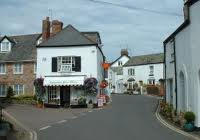‘This book is solid gold from the first chapter to the last’, says a recent review of The Houses of Lympstone, which was published last year by the Historic Houses Group. The review appears in the Journal of the Devon History Society, The Devon Historian, where the author, Roger Brien, describes Lympstone as ‘an enchanting village’. He goes on to tell us that ‘this book inspired me to visit Lympstone….Its buildings and its people are very special. There is almost something mythical about the place. Driving away, I wondered if I would ever see it again or whether it is East Devon’s version of Brigadoon’.
The illustrated book, by Rosemary Smith and Harland Walshaw, has almost sold out its first edition, but there are enough copies left to make perfect Christmas presents. They are available in Lympstone Post Office at £8.50 each.
Helen Dimond
Full review by Roger Brien:
The Houses of Lympstone : Review in the Journal of The Devon History Society (The Devon Historian)
When reviewing a local history book, the reviewer should bear in mind that such works are more often written out of passion rather than profit.That is to say hardly any author gains much financial reward due to limited interest and circulation. My view, having reviewed a number of books, is one searches for the nuggets of gold which can usually be found and are the foundation for a favourable review. In The Houses of Lympstone there are no gold nuggets. The book is solid gold from the first to the last chapter. Firstly, this is born out of the marriage of two great talents. Rosemary Smith as author conveys a great knowledge of the subject in an engaging manner. Harland Walshaw is an expert on architectural photography, with whose delightful pictures the book is peppered. Secondly, is the subject itself: Lympstone. This enchanting village, rich in history and fine architecture, makes a wonderful basis for a work of this kind. Small wonder that Peter Beecham as Designation Director for English Heritage was more than happy to write the Foreword and lay emphasis on the importance of this book as a vital record.
There is a logical and informative progression throughout the book. The introduction deals with the landscape, then the building materials available down through the centuries including the pebbles from local pebble beds that are also known as Budleigh Buns! With stone coming from as far away as Dorset, there is also an explanation regarding methods of transport.
In the chapters that follow the journey begins on Lympstone Common, crossing the A376, where a cattle market used to be held on what is now the car park of the Saddler’s Arms, then down the long approach to the village centre. Along the way there are many treats including detailed descriptions of not only the architecture of the properties (external and internal) but who lived in them and what business they were engaged in. On page 23 there is a picture of the gable end of Ventnor which still bears the legend: Taylor Military Outfitter, one of the many businesses that used to thrive in the village.
At the end of each chapter there are useful notes. Why were pineapples popular as finials particularly on gateposts during the reign of Charles II? What romantic connections did Eden Phillpots have with Lympstone? These questions are answered in the notes at the end of chapter 7.Trees, walls and the construction of paths and courtyards all get a mention.
At the end of a there is a useful map giving locations for some of the houses, from which you can readily work out the location of the rest from the book. This is followed by helpful glossary. This book inspired me to visit Lympstone. I’ve been there several times over the years, but never fully appreciated it until reading The Houses of Lympstone.
As a postscript the author added A Final View in which she expresses fears for the future of the village. These include the expansion of Exmouth and the pressure to build more houses in the parish. We should all be concerned. Lympstone, its buildings and its people are very special. There is something almost mythical about the place. Driving away from Lympstone I wondered if I would ever see it again or whether it is East Devon’s version of Brigadoon.

